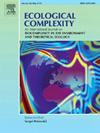Deterministic and stochastic plankton dynamics: Effects of contamination, refuge, and additional food sources
IF 3.1
3区 环境科学与生态学
Q2 ECOLOGY
引用次数: 0
Abstract
Studying plankton systems encompasses different interests, including understanding ecological cycles and developing sustainable strategies in aquaculture research regarding food security. Zooplankton farming is economically valuable, and its production may depend primarily on the availability of phytoplankton and other external food sources. However, diverse factors may affect overall phytoplankton–zooplankton interactions. For example, phytoplankton’s defense mechanisms, such as finding refuge and releasing toxins or low phytoplankton’s sustainable environments, can decrease zooplankton populations. Another critical factor is the adverse effects of pollution on plankton systems, which are more frequently present in water bodies. Still, zooplankton may survive harsh conditions if present pollutants are in low concentrations and external sources, including animal waste, are available. The partial understanding of these trophic interactions depends on initial assumptions, and using stochastic approaches may reduce the gap between deterministic mathematical outcomes and reality. In this work, we have mathematically described a planktonic system under the above assumptions using a deterministic model as well as its stochastic version. Our findings suggest that zooplankton growth is possible under polluted environments by providing them with external food sources, complementing phytoplankton availability. However, in these circumstances, random external environmental factors may cause the phytoplankton population to collapse. Through stochastic numerical experiments, we estimate which possible scenarios are more likely to induce phytoplankton extinction in these plankton systems.
确定性和随机浮游生物动力学:污染、避难所和额外食物来源的影响
研究浮游生物系统包含不同的兴趣,包括了解生态循环和在水产养殖研究中制定与粮食安全有关的可持续战略。浮游动物养殖具有经济价值,其生产可能主要取决于浮游植物和其他外部食物来源的可用性。然而,多种因素可能影响浮游植物-浮游动物的整体相互作用。例如,浮游植物的防御机制,如寻找避难所和释放毒素或低浮游植物的可持续环境,可以减少浮游动物的数量。另一个关键因素是污染对浮游生物系统的不利影响,这些系统更经常出现在水体中。尽管如此,如果目前污染物浓度较低,并且有外部来源,包括动物粪便,浮游动物可以在恶劣的条件下生存。对这些营养相互作用的部分理解取决于初始假设,使用随机方法可以减少确定性数学结果与现实之间的差距。在这项工作中,我们使用确定性模型及其随机版本在上述假设下对浮游系统进行了数学描述。我们的研究结果表明,通过为浮游动物提供外部食物来源,补充浮游植物的可用性,浮游动物在污染环境下生长是可能的。然而,在这种情况下,随机的外部环境因素可能导致浮游植物种群的崩溃。通过随机数值实验,我们估计了在这些浮游生物系统中哪些可能的情景更有可能导致浮游植物灭绝。
本文章由计算机程序翻译,如有差异,请以英文原文为准。
求助全文
约1分钟内获得全文
求助全文
来源期刊

Ecological Complexity
环境科学-生态学
CiteScore
7.10
自引率
0.00%
发文量
24
审稿时长
3 months
期刊介绍:
Ecological Complexity is an international journal devoted to the publication of high quality, peer-reviewed articles on all aspects of biocomplexity in the environment, theoretical ecology, and special issues on topics of current interest. The scope of the journal is wide and interdisciplinary with an integrated and quantitative approach. The journal particularly encourages submission of papers that integrate natural and social processes at appropriately broad spatio-temporal scales.
Ecological Complexity will publish research into the following areas:
• All aspects of biocomplexity in the environment and theoretical ecology
• Ecosystems and biospheres as complex adaptive systems
• Self-organization of spatially extended ecosystems
• Emergent properties and structures of complex ecosystems
• Ecological pattern formation in space and time
• The role of biophysical constraints and evolutionary attractors on species assemblages
• Ecological scaling (scale invariance, scale covariance and across scale dynamics), allometry, and hierarchy theory
• Ecological topology and networks
• Studies towards an ecology of complex systems
• Complex systems approaches for the study of dynamic human-environment interactions
• Using knowledge of nonlinear phenomena to better guide policy development for adaptation strategies and mitigation to environmental change
• New tools and methods for studying ecological complexity
 求助内容:
求助内容: 应助结果提醒方式:
应助结果提醒方式:


